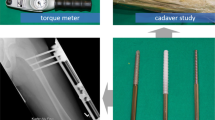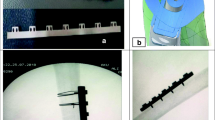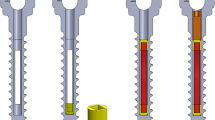Abstract
Introduction: Lengthening procedures are often complicated by loosening of pins. It has been reported that coating with hydroxyapatite improves fixation and reduces the rate of pin-track infection. Materials and Methods: We compared 47 hydroxyapatite-coated Schanz screws (HA screws) in 12 monolateral fixators mounted at the University Hospital Hamburg–Eppendorf with 45 standard stainless steel screws in 9 monolateral fixators mounted at the St Josefs-Hospital Wiesbaden by measuring the insertion and extraction torque values. The average implantation period was 7 months for the hydroxyapatite-coated screws and 5.4 months for the uncoated screws. We established the quotient of the maximum extraction torque over insertion torque which shows the change in the fixation strength with respect to time, the fixation index. It eliminates the influence of the varying pin–bone contact. Results: There was no significant difference in the rate of infection. In the Schanz screws without signs of infection the index was 1.92 for the HA screws and 0.76 for the stainless steel screws (P = 0.0002) giving evidence of the improvement of the fixation by the coating. Conclusion: HA coating resulted in improved fixation of Schanz screws in bone and may be useful in prolonged external fixation of the lower leg. The fixation index proved to be a simple tool for the evaluation of the fixation strength of Schanz screws.
Similar content being viewed by others
Avoid common mistakes on your manuscript.
Introduction
The use of external fixators is well established for the correction of leg length discrepancies and axial deformities. Complications include pin loosening and pin-track infection.
It has been reported that hydroxyapatite coating of screws and pins enhances fixation in normal and osteoporotic bone [1, 3, 5, 11]. Some authors also claim that the improvement in strength of fixation corresponds to a lower rate of pin-tract infection [7, 10].
Hydroxyapatite has widely and effectively been used as a bone substitute. Osteoconductive [6] and even osteoinductive properties [2, 4] have been described.
Insertion and extraction torque values allow us to determine screw fixation in bone [5, 8, 9, 15–17]. The aim of this paper is to complement previous investigations, including own clinical studies and cadaver experiments [13, 14], and to compare the fixation of hydroxyapatite-coated Schanz screws and stainless steel Schanz screws in a two-centre study by the use of a new index, the fixation index.
Materials and methods
We evaluated the fixation of 6 mm Schanz screws with taper shank and non-tapered thread in a monolateral fixator (Heidelberger Fixateur, Smith and Nephews, Hamburg–Schenefeld, Germany) used in the lower extremity. A total of 47 custom-made hydroxyapatite-coated Schanz screws (Ingenieurbüro Dr. Veith, Heidelberg, Germany) in 12 Heidelberger Fixateurs mounted at the Department of Orthopaedics of the University Hospital Hamburg–Eppendorf were compared with 45 standard stainless steel Schanz screws in 9 Heidelberger Fixateurs mounted at the orthopaedic clinic of the St Josefs-Hospital Wiesbaden.
The patients were treated for congenital and posttraumatic leg length discrepancies or for short stature.
The two types of screws are presented in Fig. 1. We measured the maximum torque value during the last turn of insertion and the first turn of extraction using a torque wrench with a dial gauge and drag indicator, deviation 0.4% (Rahsol Company, Solingen, Germany; Fig. 2).
The quotient maximum extraction torque over maximum insertion torque allows to appreciate the specific screw fixation strength eliminating a great number of variables which are relevant for the fixation strength of a screw in bone (such as coating, roughness, diameter, cone, thread, contact area between screw and bone, e.g. cortical vs. trabecular contact zone). It can also be used to appreciate the long-term screw fixation strength. We call it as the fixation index
 .
.
The diagnosis of relevant infections (grade 3 and 4 after Schmidt) [18] was made clinically and radiologically. The Schmidt classification is shown in Table 1.
For the comparison of both groups (HA-coated screws and standard stainless steel screws) the Mann–Whitney U test was applied, and for statistical analysis within the group the Wilcoxon test was performed.
Results
The basic patients characteristics are depicted in Table 2.
The average time of implantation was 7 months (range 3–11) for HA screws and 5.4 months (range 3–10) for the standard screws.
According to clinical and radiological criteria, 5 of the 47 HA screws (11%) and 4 of the 45 steel screws (9%) had a grade 3 or 4 infection. Early screw extraction or exchange, however, was not necessary. When there were no signs of infection, the fixation index was 1.92 ± 0.78 for the HA screws and 0.76 ± 0.29 for the standard stainless steel screws. The difference was statistically highly significant (P < 0.001).
The results are shown graphically in Fig. 3a as a Box–Whisker plot and in Fig. 3b as a scatter plot.
a Comparison of the maximum extraction torque over insertion torque quotient of HA-coated screws and stainless steel screws without signs of infection. Box–Whisker plot with minimum and maximum values, 25–75% intervals and the median values. b Comparison of the maximum extraction torque over insertion torque quotient of HA-coated screws and stainless steel screws without signs of infection. Scatter plot with the original data
The fixation index was significantly higher than 1.0 for the HA screws without signs of infection (P < 0.05), whereas the index was not significantly lower than 1.0 for the stainless steel screws without infection (0.76; P > 0.05).
As for the fixation index in the presence of infection, the difference between both (admittedly small) groups was not significant (HA screws, 0.39 ± 0.67; stainless steel screws, 0.13 ± 0.18; P > 0.05).
The standard stainless steel Schanz screws did not show any macroscopic changes after extraction. The HA-coated screws, however, showed the areas of absent HA coating (Fig. 4). We assume that the coating was torn off during removal and left behind in the pin-track because we noticed the circumscribed defects of the coating in particular in well-fixed screws which needed considerable force (torque) for removal. This points to firm bonding of the coating to the bone.
On the other hand, screws with infection which could be removed almost without any force (torque) showed thinning or vanishing of the coating but no circumscribed defects.
Discussion
Our results confirm the findings of other authors that HA-coated screws lead to an increase of bone fixation strength [1, 3, 5, 11].
We noticed circumscribed defects of the coating in particular in well-fixed screws which needed considerable force (torque) for removal. It can be assumed that the fixation of HA to bone was superior to the fixation of HA to the steel screw. We did not encounter any problems with HA particles that did remain in bone after screw removal. Knowing the favourable results of HA granulations as bone fillers [6] problems are very unlikely to occur.
The possibility that the coating was damaged during insertion can be excluded because experiments in a cadaver tibia showed that this did not occur [14].
We did not find that the use of HA coating led to a lower rate of pin-track infection described by some authors [7, 10]. In our patient material, the rate of infection was 11% for hydroxyapatite-coated screws and 9% for the control group of stainless steel screws. The difference is not statistically significant. So we could not confirm the assumption that the hydroxyapatite coating represents a prophylaxis against infection.
Previous authors have evaluated the changes in the bone fixation strength by measuring the mean extraction torque or the overall difference between extraction and insertion torque values. A high scattering of the torque values can be noted. Moroni et al. [10] mentioned for instance that in the standard pin group the mean extraction torque was 211 ± 216 N cm. In the hydroxyapatite-coated pin group, the mean extraction torque was 508 ± 233 N cm. Therefore, appreciation of the changes can be difficult. We established our fixation index in order to exclude the individual differences in bone quality and in implantation sites. The influence of the varying contact area between screw and bone is eliminated. The values of our index can be easily calculated and interpreted: a value > 1.0 clearly represents an increase of the fixation strength, whereas a value < 1.0 represents a decrease.
Pettine et al. [12] introduced a loosening index
which is more difficult to calculate and less comprehensive. The value is 0 when extraction torque does not differ from insertion torque and 100 in complete loosening. It may be negative when extraction torque is greater than insertion torque.
In our view, the simpler fixation index is preferable for clinical evaluation.
In conclusion, HA coating resulted in improved fixation of Schanz screws in bone and may be useful in prolonged external fixation of the lower leg.
The fixation index proved to be a simple tool for the evaluation of the fixation strength of Schanz screws.
Reference
Augat P, Claes L, Hanselmann KF, Suger G, Fleischmann W (1995) Increase of stability in fracture fixation by hydroxyapatite-coated bone screws. J Appl Biomater 6:99–104
Cordoba F, Dong SS, Robinson M, States BS, Nimni ME (1993) Effects of microcrystalline hydroxyapatite on bone marrow stromal cell osteogenesis. 39th Annual meeting, Orthopaedic Research Society, San Francisco, CA, pp 15–18
Dávid A, Pommer A, Eitenmüller J, Muhr G (1993) Der Einfluß der Hydroxylapatit-Beschichtung von AO/ASIF-Schrauben auf die Haftfestigkeit im Knochen. Unfallchirurg 96:12–17
Harada Y, Wang JT, Doppalapudi VA, Willis AA, Jasty M, Harris WH, Goldring SR (1994) Effects of hydroxyapatite/tricalciumphosphate particulates on human macrophage/monocytes in vitro. 40th Annual meeting, Orthopaedic Research Society, New Orleans, LA, pp 21–24
Magyar G, Toksvig-Larsen S, Moroni A (1997) Hydroxyapatite coating of threaded pins enhances fixation. J Bone Joint Surg Br 79-B:487–489 doi: 0301–620X/97/37190
Meiss L (1991) Experimentelle Untersuchungen und klinische Ergebnisse zur Stimulation der Knochenregeneration mit zerkleinerter Kortikalis und porösen Kalziumphosphatkeramiken (Trikalziumphosphat und Hydroxiapatit). Hefte zur Unfallheilkunde, Heft 216, Huggler AH, Kuner EH (Hrsg.), Springer, Berlin Heidelberg New York, pp 85–97
Moroni A, Aspenberg P, Toksvig-Larsen S, Falzarano G, Giannini S (1998) Enhanced fixation with hydroxyapatite coated pins. Clin Orthop Relat Res 346:171–177
Moroni A, Toksvig-Larsen S, Maltarello MC, Orienti L, Stea S, Giannini S (1998) A comparison of hydroxyapatite-coated, titanium-coated and uncoated tapered external fixation pins. J Bone Joint Surg Am 80-A:547–554
Moroni A, Faldini C, Marchetti S, Manca M, Consoli V, Giannini S (2001) Improvement of the bone–pin interface strength in osteoporotic bone with use of hydroxyapatite-coated tapered external fixation pins. J Bone Joint Surg Am 83-A 717–721
Moroni A, Heikkila J, Magyar G, Toksvig-Larsen S, Giannini S (2001) Fixation strength and pin tract infection of hydroxyapatite-coated tapered pins. Clin Orthop Relat Res 388:209–217
Moroni A, Faldini C, Pegreffi F, Giannini S (2004) HA-coated screws decrease the incidence of fixation failure in osteoporotic trochanteric fractures. Clin Orthop Relat Res 425:87–92
Pettine KA, Chao EY, Kelly PJ (1993) Analysis of the external fixator pin–bone interface. Clin Orthop Relat Res 293:18–27
Placzek R, Hempfing A, Meiss AL (2001) Evaluation of hydroxyapatite-coated Schanz screws used in the Heidelberg external fixation system (HEFS). Biomed Tech 46:172–175
Placzek R, Deuretzbacher G, Meiss AL (2002) Bone fixation strength of the hydroxyapatite-coated Schanz-screws of the Heidelberg external fixation system (HEFS)—determination of torque in clinical application and in a cadaver tibia. Biomed Tech 47:323–325
Pizà G, Caja VL, Gonzàlez-Viejo MA, Navarro A (2004) Hydroxyapatite-coated external-fixation pins; the effect on pin loosening and pin-track infection in leg lengthening for short stature. J Bone Joint Surg Br 86-B:892–897 doi: 10.1302/0301–620X.86B.13875
Pommer A, Muhr G, Dàvid A (2002) Hydroxyapatite-coated Schanz pins in external fixators used for distraction osteogenesis: a randomised, controlled trial. J Bone Joint Surg Am 84:1162–1166
Sandén B, Olerud C, Petrén-Mallmin M, Larsson S (2002) Hydroxyapatite coating improves fixation of pedicle screws: a clinical study. J Bone Joint Surg Br 84:387–391 doi: 0301–620X/02/312388
Schmidt HG, Neikes M, Wittek F (1990) Die Klassifikation der Osteomyelitis. Aktuelle Traumatol 20(6):303–309
Author information
Authors and Affiliations
Corresponding author
Rights and permissions
About this article
Cite this article
Placzek, R., Ruffer, M., Deuretzbacher, G. et al. The fixation strength of hydroxyapatite-coated Schanz screws and standard stainless steel Schanz screws in lower extremity lengthening. Arch Orthop Trauma Surg 126, 369–373 (2006). https://doi.org/10.1007/s00402-006-0142-5
Received:
Published:
Issue Date:
DOI: https://doi.org/10.1007/s00402-006-0142-5








